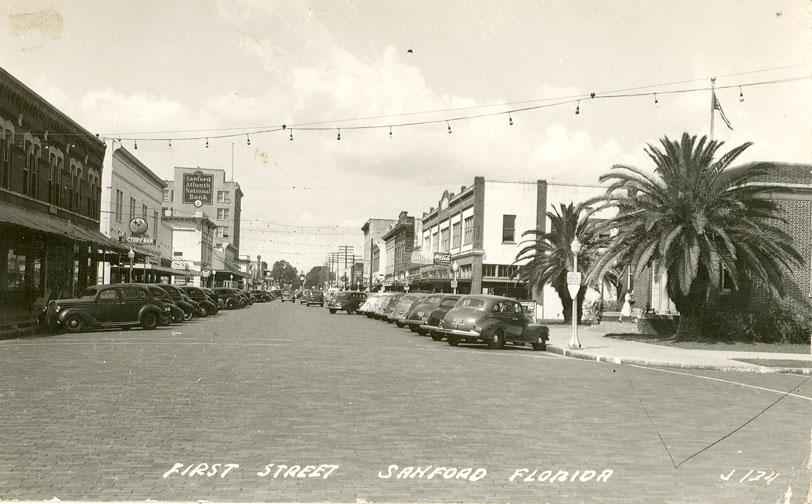Welcome to the Sanford Herald Digital Archive

Nearly 100 Years of the Sanford Herald are now digitally available.
On August 22, 1908, the Sanford Herald published its first issue. Featuring articles about the cost of purchasing and developing farm land and the details of orange culture, the first issue was named the “industrial edition” as Sanford was then known as the Gate City to Florida.
Today, news of the past is no longer limited to print. A collaborative partnership between the Museum of Seminole County History, the Sanford Museum, RICHES, and the University of Central Florida History Department resulted in a digital archive of nearly 23,000 issues, spanning nearly 100 years of news from the Celery City.
Begin your journey into the past by searching the Sanford Herald Digital Archive.
SEARCH TIPS:
Selecting Browse Items in the main navigation will take you to a list of newspaper issues.
Selecting Browse Collections in the main navigation will take you to listings of the newspaper issues by year.
The search box in the upper right hand corner can be used to locate all issues related to a specific year (e.g. "1962").
It can also be used to find a particular issue, but you must click the "..." next to the magnifying glass and select "Exact match" first. Then you can search for "April 06, 1962" and get a single result. NOTE: Day of the month is zero padded.
To search text within an issue, open the PDF file, hold the Ctrl keyboard key and press the F keyboard key (Ctrl+F).
If you would like to return to these Search Tips, select, HELP GETTING STARTED.
PLEASE NOTE:
Microforms are reproductions of documents, generally reduced to approximately one twenty-fifth of the original size. The advantages to employing this medium include lower storage, reproduction and carriage costs, as well as expanding access to collections without jeopardizing delicate or valuable items. However, photographic illustrations reproduce poorly in this format, losing clarity and halftones. Since color photographic dyes degrade the film over time and are often expensive, color materials are usually photographed using black and white film. Also, analog copies themselves degrade with each generation.
Microform to digital conversion uses an optical scanner that projects the film onto a CCD array, capturing it in a raw digital format. The physical condition of microfilm greatly impacts the quality of the digitized copy, and the medium cannot be changed or improved without rescanning the original source material.
Optical character recognition (OCR) is a field of research in pattern recognition, artificial intelligence and computer vision that mechanically or electronically converts textual images into machine-encoded text, providing automated full-text searchable files. Although OCR does not improve the quality of scans, it allows them to be electronically edited, searched, stored more compactly, displayed online, and used in machine processes.
RICHES is aware, concerned and working to resolve the problems regarding some of the poorer quality scans. We have nonetheless opted to include problematic pages and issues rather than removing them. This collection publicly has been made available at no charge as a community service in preservation through the support of the College of Arts and Humanities, the Center for Humanities and Digital Research, and the Department of History at the University of Central Florida.
For more information regarding analyzing and improving OCR accuracy in large scale historic newspaper digitization programs, please visit the following link:
Holley, Rose (April 2009). "How Good Can It Get? Analysing and Improving OCR Accuracy in Large Scale Historic Newspaper Digitisation Programs". D-Lib Magazine. Accessed April 21, 2019.
PROJECT TIMELINE:
- Original newspapers were photographed and converted to microfilm.
- E-Z Photo Scan digitized the microfilm.
- RICHES used ABBYY FineReader 12 to convert the raw digital files to OCRed files. This was a two-year process with the program operating 24-hours/day, seven days/week.
- The OCRed files were uploaded in small batches to Omeka, sorted by year into collections.
Next Phases:
RICHES is collaborating with faculty in Computer Science and the Institute for Simulation and Training to develop and test tools for improving OCR. In February 2019, Northeastern University Libraries released a Mellon Foundation-funded report titled “A Research Agenda for Historical and Multilingual Optical Character Recognition” that acknowledged the problems with OCR for all texts, but noted the systems “are much less well suited to older printed texts.” https://repository.library.northeastern.edu/files/neu:f1881m409 The National Endowment for the Humanities acted on this report to encourage submissions for grant funding to find ways to improve OCR for historical texts. Since the RICHES team was already working on this issue, we will be submitting a proposal for funding. Improvement of OCR for historic texts is a process and will not result in immediate changes, but the Sanford Herald scans will be our test data.
As the RICHES team works on a system solution, we will also start the process of rescanning the worst pages from the original newspapers. This process will require frame-by-frame analysis of the quality of the original scans, assessment of the quality of the original paper copies, scanning the originals by hand, OCR the new scans, and substituting the new scans for the old.
SPECIAL THANKS TO OUR PROJECT PARTNERS:
Sanford Herald
Museum of Seminole County History
Seminole County Historical Society
Sanford Museum
Sanford County Historical Society
Members of the community
E-Z Photo Scan
University of Central Florida History Department
RICHES